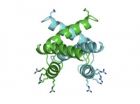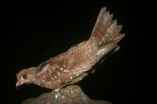(Press-News.org) Scientists at The University of Texas at Austin have discovered that a protein produced by the influenza A virus helps it outwit one of our body's natural defense mechanisms. That makes the protein a potentially good target for antiviral drugs directed against the influenza A virus.
Better antiviral drugs could help the millions of people annually infected by flu, which kills up to 500,000 people each year.
When an influenza virus infects a human cell, it uses some of the host's cellular machinery to make copies of itself, or replicate. In this study, the researchers discovered that a protein produced by human body cells, DDX21, blocks this replication process. They also discovered that a protein created by the virus, NS1, in turn blocks DDX21 and promotes viral replication.
"If you could figure out how to stop NS1 from binding to DDX21, you could stop the virus cold," said Robert Krug, a professor in the College of Natural Sciences at The University of Texas at Austin and corresponding author on the study, which appears this week in the journal Cell Host and Microbe.
Krug said that in addition to countering the body's defense mechanisms, the viral NS1 protein actually performs other important roles for the virus, such as inhibiting the host's synthesis of interferon, a key antiviral protein.
"It means that if you could block that NS1 function, you'd be blocking not only its interaction with DDX21 but many other important functions, so it's a great target," said Krug.
The need for new antiviral drugs against the influenza virus is great. Because flu vaccines are not 100 percent effective, antiviral drugs play an important role in fast-spreading epidemics. Yet influenza A viruses are developing resistance to antiviral drugs currently in use.
Krug and his team discovered that the viral NS1 protein is often associated, or bound together, with the host DDX21 protein in infected human body cells. To understand what role DDX21 might play in virus replication, the researchers used a technique called siRNA gene silencing to knock down the production of DDX21 in infected cells. When they did, virus replication increased 30 fold.
"That told us that DDX21 is a host restriction factor, that it inhibits replication," said Krug. "That was the key to understanding what was happening. It was an exciting moment."
Next, the researchers discovered that DDX21 blocks replication by binding to a protein that the virus needs to replicate, called PB1. Finally, they discovered that NS1 binds to DDX21 and makes PB1 available again for replication. This result confirmed that NS1 was indeed the countermeasure used by the virus to get around the body's natural defense mechanism.
INFORMATION:
Krug's co-authors are Guifang Chen, Chien-Hung Liu and Ligang Zhou, all from The University of Texas at Austin.
Support for this research was provided by a grant from the National Institutes of Health.
Researchers discover possible new target to attack flu virus
2014-04-10
ELSE PRESS RELEASES FROM THIS DATE:
For sick, elderly patients, surgical decision making 'takes a village'
2014-04-10
Surgical decision making for sick, elderly patients should be orchestrated by a multidisciplinary team, including the patient, his or her family, the surgeon, primary care physician, nurses and non-clinicians, such as social workers, advocates Laurent G. Glance, M.D., in a perspective piece published in the New England Journal of Medicine.
For this group of patients, surgery can be very risky. Glance, professor and vice-chair for research in the Department of Anesthesiology at the University of Rochester School of Medicine and Dentistry believes a more patient-centered, ...
Medicare's flawed adjustment methodology poor way to spend billions
2014-04-10
Lebanon, N.H. (April 10, 2014) – The methodology Medicare uses to adjust the billions of dollars it pays health plans and hospitals to account for how sick their patients are is flawed and should be replaced, according to a new study by Dartmouth investigators published in the journal BMJ that weighed the performance of Medicare's methodology against alternatives.
The researchers from the Dartmouth Atlas Project compared Medicare's current risk-adjustment methodology, which is based on the diagnoses recorded in patients' claims records, against adjustment indices based ...
American College of Physicians releases policy paper on medical liability crisis
2014-04-10
Washington, DC, April 10, 2014 -- The American College of Physicians (ACP) today released a policy paper on the medical liability crisis, which continues to have a profound effect on the medical system. "Medical Liability Reform—Innovative Solutions for a New Health Care System" provides an update of the medical liability landscape, state-based activity on medical liability reform, and summarizes traditional and newer reform proposals and their ability to affect system efficiency and encourage patient safety.
"While medical liability premiums have leveled off in the ...
New cell models for tracking body clock gene function will help find novel meds
2014-04-10
PHILADELPHIA — The consequences of modern life -- shift work, cell phone addiction, and travel across time zones -- all disturb internal clocks. These are found in the brain where they regulate sleep and throughout the body where they regulate physiology and metabolism. Disrupting the clocks is called circadian misalignment, which has been linked to metabolic problems, even in healthy volunteers.
Researchers from the Perelman School of Medicine at the University of Pennsylvania and the University of Memphis describe in PLOS Genetics the development of new cell models ...
Tumor-suppressor connects with histone protein to hinder gene expression
2014-04-10
HOUSTON -- A tumor-suppressing protein acts as a dimmer switch to dial down gene expression. It does this by reading a chemical message attached to another protein that's tightly intertwined with DNA, a team led by scientists at The University of Texas MD Anderson Cancer Center reported at the AACR Annual Meeting 2014.
The findings, also published in the journal Nature on April 10, provide evidence in support of the "histone code" hypothesis. The theory holds that histone proteins, which combine with DNA to form chromosomes, are more intimately involved in gene expression ...
Study shows 'dinosaurs of the turtle world' at risk in Southeast rivers
2014-04-10
GAINESVILLE, Fla. --- Conservation of coastal rivers of the northern Gulf of Mexico is vital to the survival of the alligator snapping turtle, including two recently discovered species, University of Florida scientists say.
A new study appearing this week in the journal Zootaxa shows the alligator snapping turtle, the largest freshwater turtle in the Western Hemisphere and previously believed to be one species, is actually three separate species.
The limited distribution of the species, known to weigh as much 200 pounds, could potentially affect the conservation of ...
How widespread is tax evasion?
2014-04-10
Tax evasion is widely assumed to be an eternal problem for governments — but how widespread is it? For the first time, a new study, co-authored by an MIT professor, has put a cost on a particular kind of tax evasion, known as "round-tripping," that the U.S. government has been trying to thwart.
In round-tripping, U.S. investors move funds to offshore tax havens, then invest in U.S. equity and debt markets with these "foreign" funds. In essence, the U.S. investors are disguising themselves as foreign investors, who are not subject to the same tax rates on capital gains ...
World ranking tracks evoluntionary distinctness of birds
2014-04-10
A team of international scientists, including a trio from Simon Fraser University, has published the world's first ranking of evolutionary distinct birds under threat of extinction. These include a cave-dwelling bird that is so oily it can be used as a lamp and a bird that has claws on its wings and a stomach like a cow.
The research, published today in Current Biology, the shows that Indonesia, Australia and New Zealand all score high on responsibility for preserving irreplaceable species. The researchers examined nearly 10,000 bird species and identified more than 100 ...
Insights into how a bird flu virus spreads could prevent pandemics
2014-04-10
The H5N1 bird flu virus has infected and killed hundreds of people, despite the fact that, at the moment, the virus can't spread easily between people. The death toll could become much worse if the virus became airborne. A study published by Cell Press April 10th in the journal Cell has revealed a minimal set of mutations allowing H5N1 to be transmitted through the air from one ferret to another. The findings will be invaluable for future surveillance programs and may provide early warning signals of the emergence of potential pandemic strains.
"By gaining fundamental ...
Genetic distinctness to guide global bird conservation
2014-04-10
In the midst of today's global extinction crisis, decisions about conservation should include prioritizing how best to preserve as much of the tree of life as possible. So say researchers who report in the Cell Press journal Current Biology on the first application of an approach to identify the most evolutionarily distinct of the world's 9,993 bird species.
At the very top of their list of the most evolutionary distinct birds is the South American oilbird, which represents almost 80 million years of evolution shared with no other bird on the planet.
"Evolutionary distinctness ...


